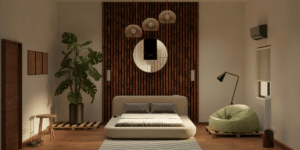Biophilic design is an innovative approach to interior design that seeks to connect occupants more closely with nature. This design philosophy is based on the concept of biophilia, which suggests that humans have an innate connection to the natural world. By incorporating natural elements into interior spaces, biophilic design aims to create environments that promote health, well-being, and productivity. This article explores the principles of biophilic design, its benefits, and practical ways to integrate nature into indoor spaces.
The Principles of Biophilic Design
Biophilic design involves integrating natural elements and processes into the built environment. It is grounded in several core principles that guide its application:
- Direct Experience of Nature: This includes incorporating natural light, plants, water features, and natural materials into interior spaces. Direct interaction with these elements can significantly enhance the sensory experience of the occupants.
- Indirect Experience of Nature: This involves using natural shapes, patterns, and colors to mimic nature. For example, incorporating natural textures and biomorphic forms can evoke the feeling of being in a natural setting.
- Space and Place Conditions: This principle focuses on creating environments that foster a sense of place and belonging. It includes designing spaces that offer refuge, mystery, and a connection to the broader environment.
Benefits of Biophilic Design for Health and Well-Being
The integration of biophilic design elements into indoor environments offers numerous benefits for physical, mental, and emotional well-being. Research has shown that exposure to nature, even in small doses, can have profound effects on health.
1. Improved Mental Health: Access to natural elements such as plants, natural light, and water features can reduce stress, anxiety, and depression. Studies have demonstrated that environments incorporating these elements can lower cortisol levels and promote a sense of calm and relaxation.
2. Enhanced Cognitive Function: Natural elements have been found to improve concentration, creativity, and cognitive performance. For instance, exposure to natural light and greenery can boost attention span and productivity, making biophilic design particularly beneficial in work and educational settings.
3. Physical Health Benefits: Natural light helps regulate circadian rhythms, leading to better sleep quality and overall health. Additionally, plants can improve indoor air quality by filtering pollutants and increasing oxygen levels.
4. Increased Well-Being and Happiness: Environments that incorporate biophilic design elements tend to enhance overall well-being and satisfaction. The presence of nature in indoor spaces can evoke positive emotions and a sense of connection to the natural world, contributing to greater happiness and contentment.
Incorporating Natural Elements into Interior Spaces
Implementing biophilic design in interior spaces involves thoughtfully integrating natural elements and principles. Here are several practical ways to incorporate biophilic design into various settings:
1. Use of Natural Light: Maximizing natural light is a fundamental aspect of biophilic design. Large windows, skylights, and glass doors can help bring in ample sunlight, creating a bright and uplifting atmosphere. Additionally, using light-diffusing materials and strategically placing mirrors can enhance the distribution of natural light throughout the space.
2. Indoor Plants and Greenery: Incorporating indoor plants is one of the simplest and most effective ways to bring nature indoors. Plants not only add visual appeal but also improve air quality and create a calming environment. Vertical gardens, potted plants, and hanging planters can be used to introduce greenery into various areas of a home or office.
3. Water Features: The presence of water can have a soothing and restorative effect. Integrating water features such as fountains, aquariums, or small indoor ponds can enhance the sensory experience and create a tranquil ambiance. The sound of flowing water can also mask unwanted noise, contributing to a more peaceful environment.
4. Natural Materials and Textures: Using natural materials like wood, stone, and bamboo can add warmth and texture to interior spaces. These materials can be incorporated into flooring, furniture, and decorative elements to create a more organic and inviting atmosphere. Additionally, using textiles and fabrics with natural patterns and textures can evoke a sense of nature.
5. Nature-Inspired Design Elements: Incorporating biomorphic forms and patterns that mimic natural shapes and structures can enhance the biophilic design of a space. This can include using wallpapers, artwork, and furnishings that feature natural motifs and designs inspired by nature.
6. Creating Views of Nature: Providing views of the outdoors can significantly enhance the connection to nature. Placing seating areas near windows with views of gardens, landscapes, or water bodies can create a sense of openness and tranquility. When outdoor views are not possible, nature-inspired artwork and murals can serve as substitutes.
7. Multi-Sensory Experiences: Biophilic design extends beyond visual elements to include other sensory experiences. Incorporating natural sounds, such as birdsong or rustling leaves, and natural scents, like essential oils or fresh flowers, can create a more immersive and holistic connection to nature.
Embracing Biophilic Design
Biophilic design offers a powerful way to enhance health and well-being by fostering a closer connection to nature. By incorporating natural elements and principles into interior spaces, it is possible to create environments that promote mental clarity, physical health, and emotional well-being. As the importance of wellness in our living and working environments continues to grow, biophilic design stands out as an effective and inspiring approach to interior design. Embracing biophilic design not only improves the quality of life for occupants but also fosters a greater appreciation for the natural world.













